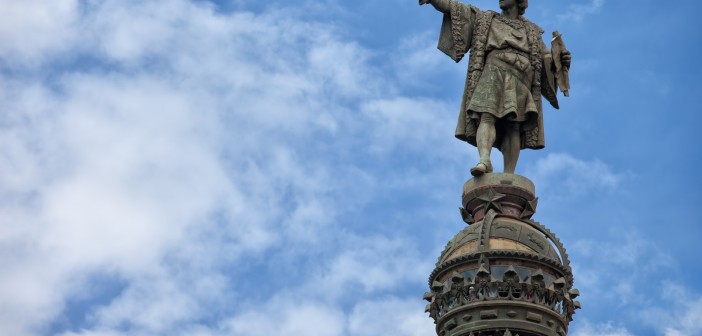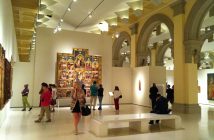It’s fairly safe to say that most people have heard of Christopher Columbus, Italian explorer and “discoverer” of the New World. However, it is somewhat less known that Barcelona, and Spain in general, had quite a large part in the success of the man’s travels.
History
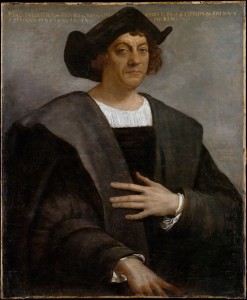 Originally, Columbus was never looking for this New World, and only happened to stumble upon it by pure chance while searching for a western route to the Eastern world in order to improve trade routes. However, from the very beginning he had a huge problem in his way: he had no money. In 1485, Columbus presented his plans of searching for a trade route through the Atlantic to King John II of Portugal and asked for 3 sturdy ships, one year’s time, be made “Great Admiral of the Ocean”, governor of any lands he discovered, and 1/10 of all revenue from those lands. In short, Columbus had big demands for an explorer. The king submitted Columbus’ proposal to his experts, who ultimately rejected it due to the fact that they believed that his estimation of a travel distance of 3,860 km (2,400 miles) was far too low.
Originally, Columbus was never looking for this New World, and only happened to stumble upon it by pure chance while searching for a western route to the Eastern world in order to improve trade routes. However, from the very beginning he had a huge problem in his way: he had no money. In 1485, Columbus presented his plans of searching for a trade route through the Atlantic to King John II of Portugal and asked for 3 sturdy ships, one year’s time, be made “Great Admiral of the Ocean”, governor of any lands he discovered, and 1/10 of all revenue from those lands. In short, Columbus had big demands for an explorer. The king submitted Columbus’ proposal to his experts, who ultimately rejected it due to the fact that they believed that his estimation of a travel distance of 3,860 km (2,400 miles) was far too low.
Not to be deterred, Columbus was back three years later (1488) to appeal to the court of Portugal once again. However, the meeting with the king did not go as well as he hoped; at the very same time, explorer Bartolomeu Dias came back to Portugal with new that he successfully rounded the southern tip of Africa. Since King John was able to use this route as a trade route with Asia, King John did not see the importance of Columbus’ voyage and ultimately rejected the proposal for good.
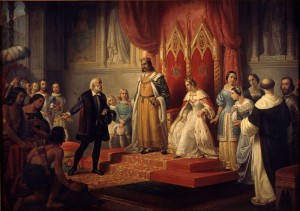 Columbus went from Portugal back to his homeland Italy, more specifically Genoa and Venice. The Italian cities rejected the countryman, and sent him on his way. Columbus even sent his brother Bartholomew to the court of Henry VII of England, but even he did not have success with his mission. It was then that Columbus sought an audience from the monarchs Ferdinand II of Aragon and Isabella I of Castille, who previously united several kingdoms throughout the Iberian Peninsula through their marriage. When Columbus’ plans were given to the savants (experts) of Spain, they marked the idea impractical and advised the royalty to reject the offer. However, the Spanish royalty did something the other kingdoms before did not; in order to keep Columbus from going elsewhere with his ideas, the monarchs gave him an annual allowance of 12,000 maravedís (gold and silver currency) and a letter ordering all cities and towns in their domain to provide him food and lodging at no cost.
Columbus went from Portugal back to his homeland Italy, more specifically Genoa and Venice. The Italian cities rejected the countryman, and sent him on his way. Columbus even sent his brother Bartholomew to the court of Henry VII of England, but even he did not have success with his mission. It was then that Columbus sought an audience from the monarchs Ferdinand II of Aragon and Isabella I of Castille, who previously united several kingdoms throughout the Iberian Peninsula through their marriage. When Columbus’ plans were given to the savants (experts) of Spain, they marked the idea impractical and advised the royalty to reject the offer. However, the Spanish royalty did something the other kingdoms before did not; in order to keep Columbus from going elsewhere with his ideas, the monarchs gave him an annual allowance of 12,000 maravedís (gold and silver currency) and a letter ordering all cities and towns in their domain to provide him food and lodging at no cost.
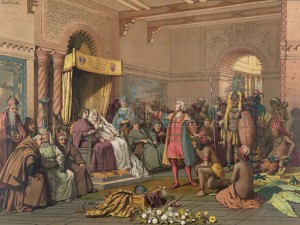 After two years of negotiations with the Spanish crown, Columbus finally hit success in January 1492. The Catholic Monarchs had just conquered Granada, the last Muslim stronghold on the Iberian Peninsula, and received Columbus in Córdoba. During this meeting, Isabella turned Columbus down due to the advice of her confessor, and Columbus was sent packing. Before he could leave the city walls, Ferdinand intervened and sent a royal guard to fetch him (causing Ferdinand to later claim credit for being “the principal cause why those islands were discovered”). In April of the same year, the Catholic Monarchs agreed to Columbus’ demands in the “Capitulations of Santa Fe”, with the additional reward of buying 1/8th interest in any commercial venture in the new lands.
After two years of negotiations with the Spanish crown, Columbus finally hit success in January 1492. The Catholic Monarchs had just conquered Granada, the last Muslim stronghold on the Iberian Peninsula, and received Columbus in Córdoba. During this meeting, Isabella turned Columbus down due to the advice of her confessor, and Columbus was sent packing. Before he could leave the city walls, Ferdinand intervened and sent a royal guard to fetch him (causing Ferdinand to later claim credit for being “the principal cause why those islands were discovered”). In April of the same year, the Catholic Monarchs agreed to Columbus’ demands in the “Capitulations of Santa Fe”, with the additional reward of buying 1/8th interest in any commercial venture in the new lands.
After his successful venture to the New World, Columbus returned to Spain at the port of Barcelona on March 15, 1493. The crew of the remaining ships came home to a hero’s welcome, and showed to the city and its monarchs the spoils of his trip, including gold, jewelry, flowers, tobacco plants, pineapples, turkeys, and the hammock. Columbus himself was richly rewarded by dining with the Catholic Monarchs, and was even given his own coat of arms.
The Columbus Monument
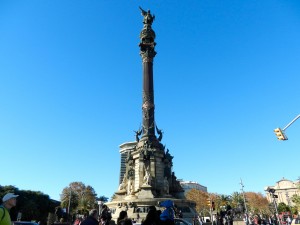 Celebrating Columbus’ return to Spain through Barcelona, the Columbus Monument was constructed in 1888 for the Exposición Universal de Barcelona. Located at the lower end of the street of La Rambla, the monument serves as a reminder that Christopher Columbus reported to Queen Isabella I and King Ferdinand V (previously known as Ferdinand II) in Barcelona after his first trip to the New World. The 40 m (131 ft) tall column holds a 7.2 m (24 ft) tall bronze statue depicting Columbus pointing towards the New World with his right hand, while the left holds a scroll. At the base of the column stands a pedestal with portraits of people related to Columbus, as well as a plinth with important scenes in Columbus’ first voyage to the Americas.
Celebrating Columbus’ return to Spain through Barcelona, the Columbus Monument was constructed in 1888 for the Exposición Universal de Barcelona. Located at the lower end of the street of La Rambla, the monument serves as a reminder that Christopher Columbus reported to Queen Isabella I and King Ferdinand V (previously known as Ferdinand II) in Barcelona after his first trip to the New World. The 40 m (131 ft) tall column holds a 7.2 m (24 ft) tall bronze statue depicting Columbus pointing towards the New World with his right hand, while the left holds a scroll. At the base of the column stands a pedestal with portraits of people related to Columbus, as well as a plinth with important scenes in Columbus’ first voyage to the Americas.
The idea of a monument to Columbus came in 1856 from Antoni Fages i Ferrer, but didn’t get any support for 16 years. In 1872 he finally gained the backing of the mayor of the city, Francesc Rius i Taulet, and in 1881 the city passed a resolution to build the monument. A contest was held for Spanish artists to submit their designs, with artist Gaietà Buigas i Monravà being the winner. Most of the money to build the monument was privately raised, with only 12% being public funds. All funding came from Spanish sources and the entire construction was done by Catalans in an attempt to keep the project solely of local craft. Construction began in 1882, and was completed in 1888 in time for the 1888 Barcelona Universal Exposition.

